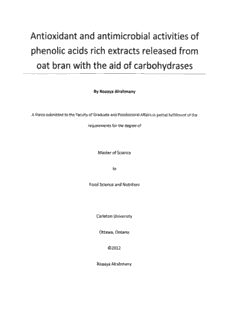
Antioxidant and antimicrobial activities of phenolic acids rich extracts released from oat bran with PDF
Preview Antioxidant and antimicrobial activities of phenolic acids rich extracts released from oat bran with
Antioxidant and antimicrobial activities of phenolic acids rich extracts released from oat bran with the aid of carbohydrases By Roaaya Alrahmany A thesis submitted to the Faculty of Graduate and Postdoctoral Affairs in partial fulfillment of the requirements for the degree of Master of Science In Food Science and Nutrition Carleton University Ottawa, Ontario ©2012 Roaaya Alrahmany 1+1 Library and Archives Bibliotheque et Canada Archives Canada Published Heritage Direction du Branch Patrimoine de I'edition 395 Wellington Street 395, rue Wellington Ottawa ON K1A0N4 Ottawa ON K1A 0N4 Canada Canada Your file Votre reference ISBN: 978-0-494-94292-5 Our file Notre reference ISBN: 978-0-494-94292-5 NOTICE: AVIS: The author has granted a non L'auteur a accorde une licence non exclusive exclusive license allowing Library and permettant a la Bibliotheque et Archives Archives Canada to reproduce, Canada de reproduire, publier, archiver, publish, archive, preserve, conserve, sauvegarder, conserver, transmettre au public communicate to the public by par telecommunication ou par I'lnternet, preter, telecommunication or on the Internet, distribuer et vendre des theses partout dans le loan, distrbute and sell theses monde, a des fins commerciales ou autres, sur worldwide, for commercial or non support microforme, papier, electronique et/ou commercial purposes, in microform, autres formats. paper, electronic and/or any other formats. The author retains copyright L'auteur conserve la propriete du droit d'auteur ownership and moral rights in this et des droits moraux qui protege cette these. Ni thesis. Neither the thesis nor la these ni des extraits substantiels de celle-ci substantial extracts from it may be ne doivent etre imprimes ou autrement printed or otherwise reproduced reproduits sans son autorisation. without the author's permission. In compliance with the Canadian Conformement a la loi canadienne sur la Privacy Act some supporting forms protection de la vie privee, quelques may have been removed from this formulaires secondaires ont ete enleves de thesis. cette these. While these forms may be included Bien que ces formulaires aient inclus dans in the document page count, their la pagination, il n'y aura aucun contenu removal does not represent any loss manquant. of content from the thesis. Canada a il ^UlJ In The Name of Allah, The All-Merciful, The Ever-Merciful Table of content List of Abbreviations.............................................................................................................................1 List of Figures........................................................................................................................................2 List of Tables.........................................................................................................................................3 Dedication................................... 4 Acknowledgments................................................................................................................................5 Abstract.................................................................................................................................................6 Chapter 1: Introduction.......................................................................................................................8 Hypothesis..........................................................................................................................................9 Objectives...........................................................................................................................................9 Chapter 2: Literature Review............................................................................................................10 Reactive oxygen species (ROS).........................................................................................................10 Formation of reactive oxygen species................................................................................................................................10 The role of ROS.........................................................................................................................................................................13 Reactivity and toxicity of ROS...........................................................................................................14 Lipid peroxidation (LPO):.......................................................................................................................................................15 DNA damage:............................................................................................................................................................................17 Protein oxidation:....................................................................................................................................................................18 Human antioxidant defense system.................................................................................................20 Enzymatic antioxidants:.........................................................................................................................................................21 Non-enzymatic antioxidants:................................................................................................................................................22 Dietary antioxidant compounds.......................................................................................................23 Oat and its nutrients.........................................................................................................................24 Oat nutrients..............................................................................................................................................................................25 Extraction methods for polyphenols in cereals..................................................................................30 Chapter 3: Methodology....................................................................................................................33 Material and chemicals.....................................................................................................................33 Preparation of phenolic extracts.......................................................................................................33 Determination of total phenolic content (TPC).................................................................................35 Antioxidant activity assays...............................................................................................................35 Determination of oxygen radical absorbance capacity (ORAC).....................................................................................35 Determination of Hydroxyl Radical Averting Capacity (HORAC)...................................................................................36 Hydroxyl radical (HO) scavenging assay............................................................................................................................37 Superoxide scavenging activity.............................................................................................................................................37 Determination of free radical scavenging activity by DPPH assay................................................................................38 Metal chelating assay.............................................................................................................................................................38 Inhibition of linoleic acid autoxidation...............................................................................................................................39 Extraction of phenolic acids for HPLC analysis..................................................................................................................39 HPLC analysis............................................................................................................................................................................40 Antimicrobial activity........................................................................................................................41 Chapter 4: Results and discussion....................................................................................................42 Polysaccharide degradation.............................................................................................................42 Total phenolic content.....................................................................................................................43 Oxygen radical absorbance capacity (ORAC) assay...........................................................................44 Hydroxyl Radical Antioxidant Capacity (HORAC) and Hydroxyl radical scavenging activity...............47 Superoxide scavenging activity.........................................................................................................50 Diphenyl-l-picrylhydrazyl (OPPH) radical scavenging activity..........................................................51 Metal chelation................................................................................................................................53 Inhibition of linoleic acid auto-oxidation...........................................................................................54 Phenolic acid content........................................................................................................................56 Antimicrobial activity........................................................................................................................60 Chapters: Conclusion.........................................................................................................................63 Summary...........................................................................................................................................63 Future work......................................................................................................................................64 References..........................................................................................................................................65 iii List of Abbreviations (ROS) Reactive oxygen species (SOD) Superoxide dismutase (GSH) Glutathione (PUFA) Polyunsaturated fatty acid (NADPH oxidases) Nicotinamide adenine dinucleotide phosphate oxidases (ATP) Adenosine-5-triphosphate (LPO) Lipid peroxidation (MDA) Malondialdehyde (CAT) Catalase (GPX) Glutathione peroxidise (AV) Avenanthramide (ORAC) Oxygen Radical Absorbance Capacity (HORAC) Hydroxyl Radical Averting Capacity (DPPH) 2,2-diphenyl-l-picrylhydrazyl (HPLC) High Performance Liquid Chromatography (8-OHdG) 8-hydroxydeoxyguanosine (GAE) Gallic acid equivalent 1 List of Figures Figure 1 ROS generation [17]........................................................................................................... 11 Figure 2:8-OHdg formation by free radicals [27]........................................................................... 18 Figure 3: Oat anatomy [43;a]........................................................................................................... 24 Figure 4 : Avenanthramide chemical structure.............................................................................. 27 Figure 5 : some of the phenolic acids that are found in oats....................................................... 28 Figure 6 some of flavones that are found in oats.......................................................................... 29 Figure 7: most common lignan chemical structure....................................................................... 29 Figure 8: Phytic acid chemical structure......................................................................................... 30 Figure 90: Effects of control and carbohydrases treated samples on the growth of microorganisms. (A): Bacillus subtilis. (B): Escherichia coli........................................................... 62 2 List of Tables Table 1 Oat nutrients.........................................................................................................................25 Table 2 Extraction condition of medium oat bran samples............................................................34 Table 3 Reducing sugar and total phenolic content........................................................................43 Table 4 Phenolic acids in control and different enzyme-treated oat bran samples....................59 3 Dedication This thesis is lovingly dedicated to The people who were supporting and waiting for this achievement, but left before. The people who support me back home especially mom and brother. My family, Emad, Raghad, Yousof, Abbas and Abdumalik who have been my constant source of inspiration and supported me each step of the way to achieve what I dreamed of. My best friends who always beside me, Dina Almohsen. 4
Description: